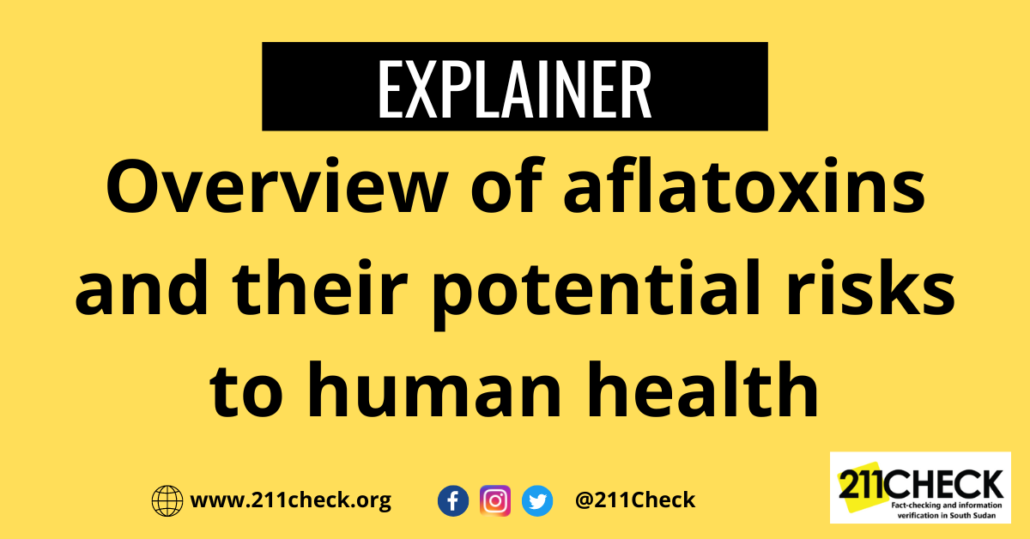Explainer: Aflatoxins – What You Need to Know
Aflatoxin is a dangerous toxin produced by fungi that grow on crops and can cause cancer, liver damage, and growth problems in humans and animals. It is a significant food safety issue in many parts of the world, especially in developing countries.
Writer: Beatrice Amude Paulino
A media report by South Sudan’s Juba-based Eye Radio says the South Sudan Bureau of Standards has impounded forty containers of maize flour from Uganda at the Nimule border on claims that they are affected by Aflatoxin fungi according to preliminary laboratory tests.
“At least 40 containers of substandard maize flour were confiscated at the Nimule border,” said the South Sudan Bureau of Standards Chief Executive Officer, Mary Gordon.
‘’We found some substances in the food items, especially the maize flour from Uganda. It has not expired, but the chemical ( aflatoxin) acquired harms human consumption. Forty containers have been stopped from proceeding to Juba,’’ said the clearance Agents Association Chairperson, Daniel Deng
Courtesy image
211 Check takes a look at how this type of fungi affects food, and here is what we found out:
What is Aflatoxin?
Aflatoxins are a family of toxins produced by certain fungi found on crops such as maize (corn), peanuts, cottonseed, and tree nuts. The primary fungi that produce aflatoxins are Aspergillus flavus and Aspergillus parasiticus, which are abundant in warm and humid regions of the world. Aflatoxin-producing fungi can contaminate crops in the field, at harvest, and during storage.
People can be exposed to aflatoxins by eating contaminated plant products (such as peanuts) or meat or dairy products from animals that ate contaminated feed. Farmers and other agricultural workers may be exposed by inhaling dust generated while handling and processing contaminated crops and feeds.
Image showing corn infected by aflatoxin
What are the common causes of aflatoxin?
Aflatoxin is caused by certain strains of fungi, such as Aspergillus flavus and Aspergillus parasiticus. These fungi are commonly found in soil and can grow on crops such as peanuts, cottonseed, corn, and tree nuts, especially when stored in warm and humid conditions. The fungi produce aflatoxin as part of their natural metabolic processes, which can contaminate food and feed products. Factors that can increase the risk of aflatoxin contamination include poor storage conditions, improper handling and processing of crops, and insect damage to crops. Climate conditions such as drought or excessive rainfall can also contribute to higher levels of crop aflatoxin production.
What are the dangers of exposing people to aflatoxin?
Aflatoxin is a Potent Carcinogen that can cause liver damage, immune system suppression, and growth impairment in humans and animals. The health effects of aflatoxin exposure depend on the level and duration of exposure, as well as individual susceptibility. In acute high-level exposure cases, symptoms may include liver damage, vomiting, abdominal pain, and convulsions. Chronic exposure to low levels of aflatoxin over a prolonged period may increase the risk of developing liver cancer, particularly in populations with existing liver diseases, such as hepatitis B or C infections. Aflatoxin exposure has also been linked to other types of cancer, including lung and colorectal cancer. Children and infants are particularly vulnerable to the harmful effects of aflatoxin, which can result in stunted growth, malnutrition, and impaired immune function.
Ways of preventing aflatoxin from contaminating food
Aflatoxin is a type of toxin produced by certain moulds, especially Aspergillus flavus and Aspergillus parasiticus. It can contaminate many crops, including grains, nuts, and seeds, and is a significant food safety concern worldwide.
There are several ways to prevent aflatoxin contamination in food:
- Proper storage: Aflatoxin-producing moulds thrive in warm, humid conditions. Therefore, storing food in excellent, dry places can help prevent the growth of these moulds.
- Good agricultural practices: Farmers can reduce the risk of aflatoxin contamination by using good agricultural practices such as crop rotation, proper irrigation, and timely harvesting and storage of crops.
- Biological control: Several strains of non-toxic Aspergillus fungi can be used to compete with and displace the toxic strains that produce aflatoxin.
- Chemical control: Fungicides can be applied to crops to control the growth of aflatoxin-producing moulds.
- Screening and testing: Regular screening and testing of food products for the presence of aflatoxin can help identify contaminated batches before they enter the food supply chain.
It’s important to note that prevention is vital regarding aflatoxin, as there is no practical way to remove it once it has contaminated food. Therefore, taking proactive steps to prevent contamination is critical for protecting human health.
How can farmers reduce the risk of aflatoxin?
Farmers can take several steps to reduce the risk of aflatoxin contamination in their crops:
- Crop management: Proper crop management practices can help reduce the risk of aflatoxin contamination. This includes planting resistant varieties, using proper irrigation techniques, and ensuring that crops are harvested at the correct time.
- Pest control: Pests such as insects and rodents can damage crops and create favourable conditions for the growth of aflatoxin-producing moulds. Farmers can minimise pest damage through integrated pest management practices, which may include cultural, biological, and chemical controls.
- Drying and storage: Aflatoxin-producing moulds thrive in warm, humid environments. Therefore, farmers should ensure that crops are dried and stored in excellent conditions. This can be achieved using drying and storage facilities that maintain appropriate temperature and humidity levels.
- Regular monitoring: Farmers should regularly monitor their crops for signs of mould growth and other indicators of aflatoxin contamination. This can involve visual inspections and laboratory testing samples from different farm areas.
- Training and education: Farmers can benefit from training and educational programs that teach them about the risks of aflatoxin contamination and the best prevention practices. This can include information on crop management, pest control, and proper drying and storage techniques.
Farmers can help reduce the risk of aflatoxin contamination in their crops by taking these steps, leading to safer and healthier food for consumers.
Treatment for aflatoxin infection
The treatment for aflatoxin exposure depends on the severity of the illness and the specific symptoms exhibited. Hospitalisation may be necessary in cases of acute poisoning to manage symptoms such as vomiting, dehydration, and convulsions. Supportive care may also be required, including intravenous fluids, electrolyte replacement, and nutritional support.
However, there is no specific antidote for aflatoxin poisoning, and treatment mainly focuses on managing symptoms and preventing further exposure. In cases of chronic exposure, long-term monitoring and management of liver function may be necessary to reduce the risk of developing liver cancer. Prevention is the most effective way to reduce the risk of aflatoxin exposure, which includes measures such as proper storage and handling of food and feed products, regular testing for contamination, and strict regulatory controls.
Conclusion
It is essential to prevent or reduce aflatoxin contamination by implementing good agricultural practices, proper storage conditions, and regular monitoring of crops for aflatoxin levels. The Government has already started screening or examining food and non-food items imported into the country at the border.
To ensure accuracy and transparency, we at 211 Check welcome corrections from our readers. If you spot an error in this article, please request a correction using this form. Our team will review your request and make the necessary corrections immediately, if any.


